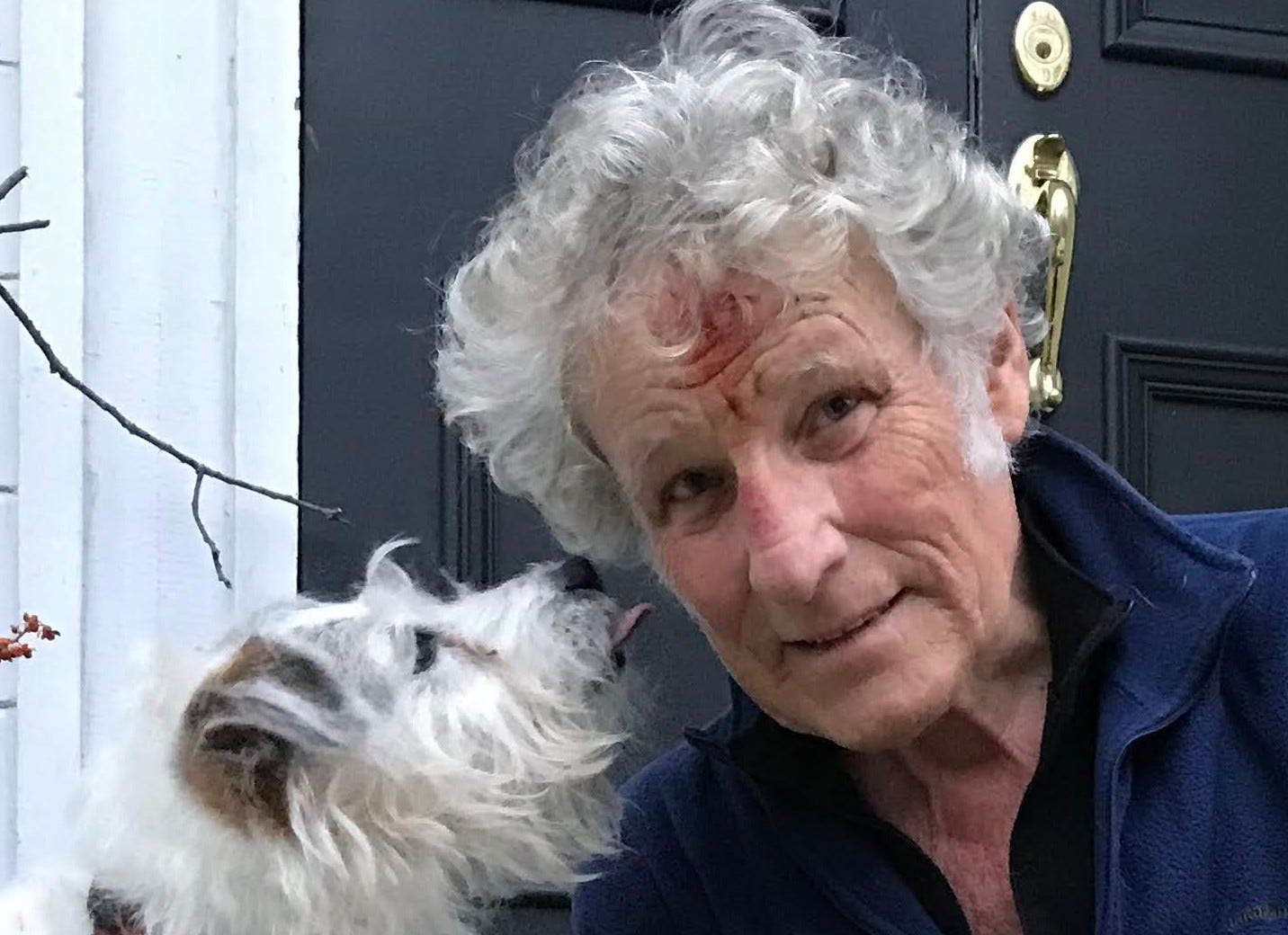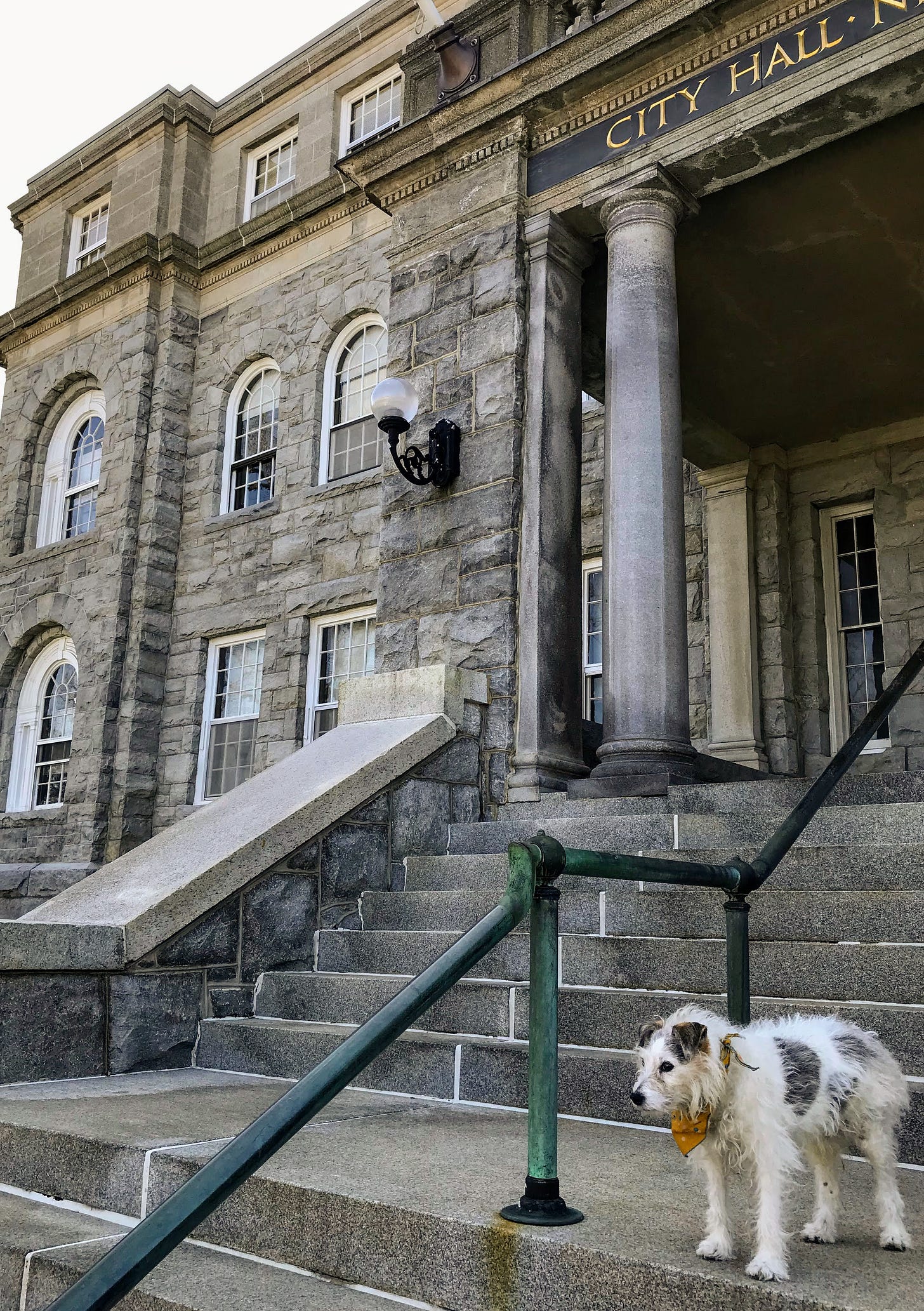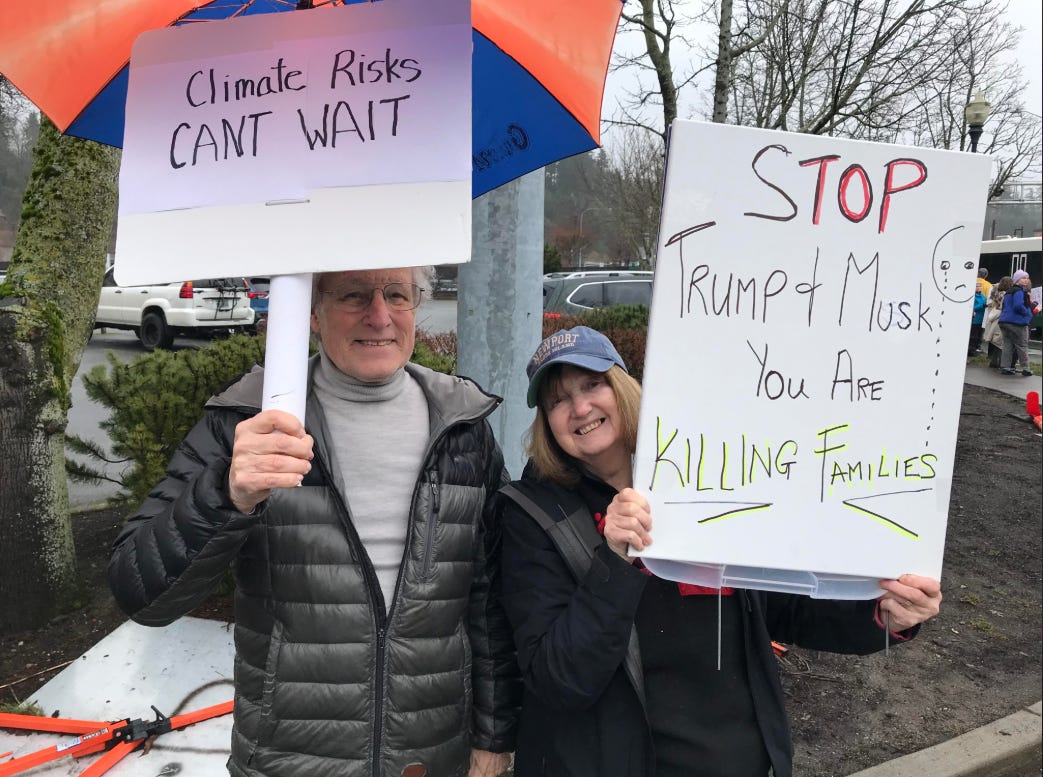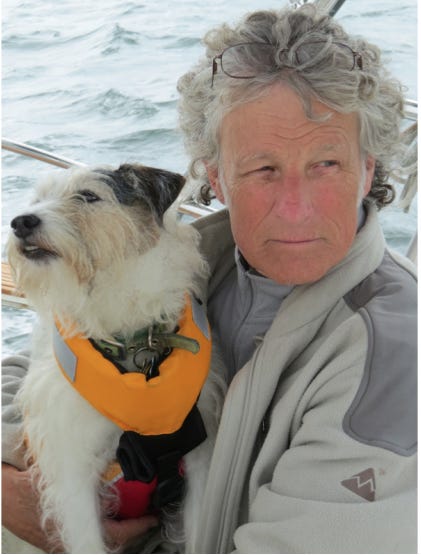I’ve been trying to figure out how best to handle the pain coming from Trump’s White House. I’ve watched the wide-ranging injuries he is inflicting on America and the world, making me and so many others more miserable each week.
This is actually a good moment for me to weigh alternative approaches to managing pain. Yesterday I had the third and final session of outpatient surgery called Cervical Radiofrequency Ablation to destroy a nerve in my neck and quiet my long-time arthritis.
This morning I woke up pain-free!
I’ve spent the week working on an analogy for this newsletter, comparing the various ways of treating physical pain - by using physical therapy, pain medicine, and finally the nerve block I had yesterday - against the ways I’ve been trying to deal with the daily pain which the news produces - by using hope, resolve, protest gatherings, angry screeds, or maybe a little acceptance or even tuning out.
I reached two conclusions.
For the growing damage to my neck, choosing not to keep trying to cure the pain but instead to obscure it is effective and humane.
For the growing damage to our environment, our democracy, and our grandchildren’s future, blocking the pain is neither effective nor humane. Tuning out will not help me or anyone.
Starting today, I hope my concentration improves in daily life. I also hope that, as I write ClimateDog, I can focus better. Especially on analogies.
I used to find plenty of stories for these newsletters. I’d ask, ‘What can we do to help fight climate change and its effects?’ Buddy would research it. Then I’d write it.
But the last few months have cut down on the answers to that question.
Emissions regulation is being reversed, and
Funding for climate protections is gone, at least temporarily.
So I’m apologizing for writing these days more about what we can do politically to fight against, not climate change, but our federal government. I realize that’s not what many subscribers signed onto ClimateDog to read. But to face up to the climate threat, America first has to face up to the political threat. The question is how.
A recent tutorial
Hilary tells the story.
Last weekend David and I were standing in front of the local courthouse waving our posters at passing cars. It was the national ‘Hands Off’ rally. I turned to find a couple of kids walking behind us. They stopped. We all introduced ourselves. Such sudden connections are of course part of the scene at protests. We talked about what the future might hold for us all. And how important campaigning is going to be, especially knocking on doors.
The girl asked us if we had read Yale professor Timothy Snyder's book On Tyranny. ‘Oh yes!,’ we both said. She then told us she had brought with her 10 copies of that little book to hand out to fellow protesters who had yet to read it.
I was amazed. I never would have thought of giving that little book to strangers. But it contains deeply disturbing examples of how democracies were lost unwittingly to fascism throughout history - and how we act to avoid that fate today! [Hilary]
Three lessons from that moment
Three questions I’ve been pondering were answered by that chat with the college kids.
How do we politely involve others around us who are not climate activists? Protest leaders tell us, ‘Now go out and recruit family, friends and neighbors for the next rally.’ That’s an uncomfortable assignment for most of us who really don’t want to start a conversation on politics. But here’s another approach: just give them the book and say something like ‘This has lots of ideas about dealing with the current political environment - for both liberals AND conservatives.’
Whom should we try to involve? These two kids were very concerned about climate change. Their generation will be particularly hurt by its progress and should be particularly willing to fight to slow it down. We should find more ways to help them join - and lead - climate actions.
Are there lessons in On Tyranny that apply to those of us trying to reduce emissions and protect ourselves against climate damage?
I think the book’s very first lesson is particularly apt at the moment. Snyder writes:
Do not obey in advance
Most of the power of authoritarianism is freely given. In times like these, individuals think ahead about what a more repressive government will want, and then offer themselves without being asked. A citizen who adapts in this way is teaching power what it can do. [Timothy Snyder, On Tyranny]
Many progressives are simply lying down in front of Trump’s steamroller. Some have said to me, "Gotta wait it out. Can’t do anything at the moment?”
It may be that our letters, our placards, our bumper stickers, our rallies, even our living room meetings with friends, don't have much immediate effect. But those actions will keep us angry, and they will show everyone around us that we’re angry and are not lying down. We are ready to rise up. We are not obeying in advance.
And hey, just as Trump swung overnight from huge tariffs to no tariffs for 90 days, maybe he’ll think better and suddenly release the Inflation Reduction Act funds for climate protections. To explain his huge about-face this week, Trump said, ‘Over the last few days I thought that people [in the investment industry] were getting yippy. They were getting a little bit afraid.’
Let’s make sure he knows that Americans with climate concerns are getting really yippy.
Timothy Snyder writes a Substack newsletter called Thinking About. His letter From the Storm to the Stormtroopers, The Facist Logic of Climate Lying about ‘impotence politics’ is particularly apt.
It’s not hard to find moments to lobby lawmakers, join protests, and wave posters for the climate actions and policies we favor. The Take Action Network (TAN), Mobilize.us, and other protest calendars link us to these opportunities. It’s a time-saving way to push the political world toward what we yearn for - like boosting our climate protections and emission reductions.
Of course, such political efforts can also support access to abortion, gun rights, reducing homelessness, building affordable housing, feeding the poor, gun control, and an extensive mixture of Americans’ goals.
It’s that mixture that’s hurting us
There is a new awareness of how many of these progressive causes interfere with each other, slowing or preventing actual progress. An example of this self-interference:
US legislation in 2021 provided $42bn to expand broadband internet in rural America. As of last December, the program had yet to connect a single household. The project has been slowed to a halt because of federal conditions that require states to assure their projects contain plans for climate change, reach out to unionized workforces, and hire locally. [Ezra Klein, Derek Thompson]
Trying to help humanity in multiple ways tangled and stymied this broadband project.
On the other hand, consider a different project, freed from extra do-gooder requirements, whose progress was spectacular:
A bridge collapsed in Pennsylvania in 2023, crippling an essential highway. To fix it would typically take months of planning, consultation and reviews; Governor Josh Shapiro instead declared a state of emergency that allowed the reconstruction of the bridge with union labor but free from many normal processes. The highway reopened in 12 days, instead of the 12 to 24 months that it might have taken. [Ezra Klein, Derek Thompson]
Klein, Thompson and others point out that decades of progressive policies have been aimed at protecting against government abuses - but that many of them are preventing governments, at every level, from building quickly or affordably. Their research and theory is set forth in their new book Abundance.
How to prevent saddling one issue with others
It’s easy to see how a project aimed at, say local flood control, can treat residents in uncaring ways. If we hire a non-local contractor we forgo local jobs. If we avoid input from farmers, abutters, boaters, indigenous neighbors, fishermen, and anyone who likes the view as it is, we stonewall their diverse needs.
But that’s the point. Needs can be so diverse that the project can’t meet them all. It stumbles. And most lawmakers, regulators, and other elected officials cannot eschew these goals. So how can we prevent conflicting goals from holding a project back?
An unlikely possibility is to get the government to declare a state of emergency, as Josh Shapiro did. Locally, many counties do have the right to declare a state of emergency, but it usually requires a ‘threat of widespread damage, injury, or loss of life or property,’ and is not usually applicable to forward-looking adaptation projects like flood control.
An approach that’s having success is to leave government out of the project. A striking instance is the discovery of how to build new supportive housing in San Francisco. It seems to depend on forgoing all government funding and relying instead on private philanthropy to get it done.
The increasing privatization of affordable housing may be leading the way. The San Francisco Housing Accelerator Fund has recruited Apple and other San Jose-based companies to back the Bay Area Housing Innovation Fund.
‘Getting projects financed through the state has been creating both long delays and massive funding escalations,’ said Jennifer Loving, CEO of Destination: Home, one of the beneficiary organizations.
The $50 million pilot fund will help finance at least four projects, with nearly half the homes for extremely low-income households for formerly homeless residents. The fund offers favorable loans to projects that can build affordable homes faster and more cost effectively to achieve a cost and time savings of 40 percent. [San Francisco Herald]
As the new Administration dries up funding for our climate adaptation projects from the Inflation Reduction Act (IRA), we might find a way to get help from one of the large national or regional philanthropies engaged in building climate defenses - groups like
The McKnight Foundation’s Climate & Energy Program which funds grassroots climate adaptation initiatives in the Midwest, including urban tree planting to combat rising temperatures.
The Gordon and Betty Moore Foundation which invests in watershed conservation to ensure long-term water security for cities and agricultural regions.
The Bezos Earth Fund which has supported projects in coastal cities to restore wetlands and mangroves, which act as natural buffers against sea-level rise.
More likely we can find - or help create - local philanthropies to fund our climate-change projects, organizations like
The Central Texas Community Foundation which funds local flood prevention, drought resilience, and wildfire mitigation projects in and near Austin, such as restoring buffers along the Colorado River to prevent erosion and flooding.
The East Bay Community Foundation in Oakland, CA which funds disaster prevention for vulnerable populations, including tree-planting and cooling strategies.
And if we want our donations and actions to combine climate action with another social goal (e.g. the East Bay Foundation combining support for vulnerable populations), there are organizations that can help us do that.
Want to identify county- and municipal-level philanthropies funding local climate adaptation projects? Check these directories.
Candid (Formerly GuideStar)
Community Foundation Locator (Council on Foundations)
The ClimateWorks Foundation – Funding Partners List
The Funders Network – Climate Resilience & Sustainability Program
The Solutions Project – 100% Community-Led Climate Funders
Local community foundation Networks, such as the League of California Community Foundation, and the New England Grassroots Environment Fund
Despite donating 3 - 15 times more money to charity than other wealthy nations, Americans are unlikely to find enough foundation money to revive the really big climate projects that are being strangled under the IRA. But foundation money brings two advantages over government money. First, grant committees, unlike government legislatures and administrators, need not satisfy multiple, perhaps conflicting, constituencies in a single grant. Second, the costs can be lower.
It remains to be seen whether Washington’s funding for climate actions has dropped permanently but, even if it hasn’t, an effort to interest foundations in filling the gap could pay off long-term.
And of course, in addition to seeking climate-oriented foundation grants for our favorite adaptation projects, we can help by contributing to those organizations, maybe even specifying how we want our donation to be used.
We can read a deeper dive into philanthropies’ attitudes toward climate change in this article in Hothouse, a multi-author newsletter from my fellow Substack writers.
Loading more posts…











